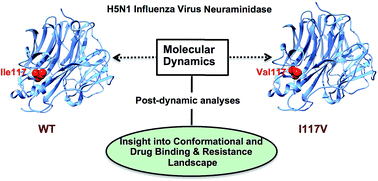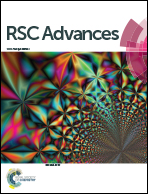Single H5N1 influenza A neuraminidase mutation develops resistance to oseltamivir due to distorted conformational and drug binding landscape: multiple molecular dynamics analyses†
Abstract
Clinical studies showed that a single mutation, I117V, develops severe resistance to oseltamivir, the first orally active influenza A neuraminidase inhibitor, in highly pathogenic H5N1 influenza A viruses. However the molecular mechanism by which this single mutation confers oseltamivir resistance is not well understood. Herein, and via “multiple” molecular dynamics approaches, we conducted a comparative study on the wild type and I117V mutant to understand the origin of resistance at the molecular level using a wide range of post-dynamics analytical tools. These include binding free energy calculations (MM/GBSA), principal component analysis (PCA), radius of gyration (RG), per-residue fluctuation (RMSF), solvent accessible surface area (SASA) and per-residue secondary structure occupancy. Results showed that single mutations at position 117 of H5N1 caused (1) distortion of the orientation of oseltamivir in the active site, (2) decrease in the binding affinity by ∼6 kcal mol−1 when compared to the wild type, (3) variation in the overall enzyme motion as evident from the PCA for both systems and (4) distortion of the hydrogen bonding network and atomic interactions with the inhibitor.


 Please wait while we load your content...
Please wait while we load your content...